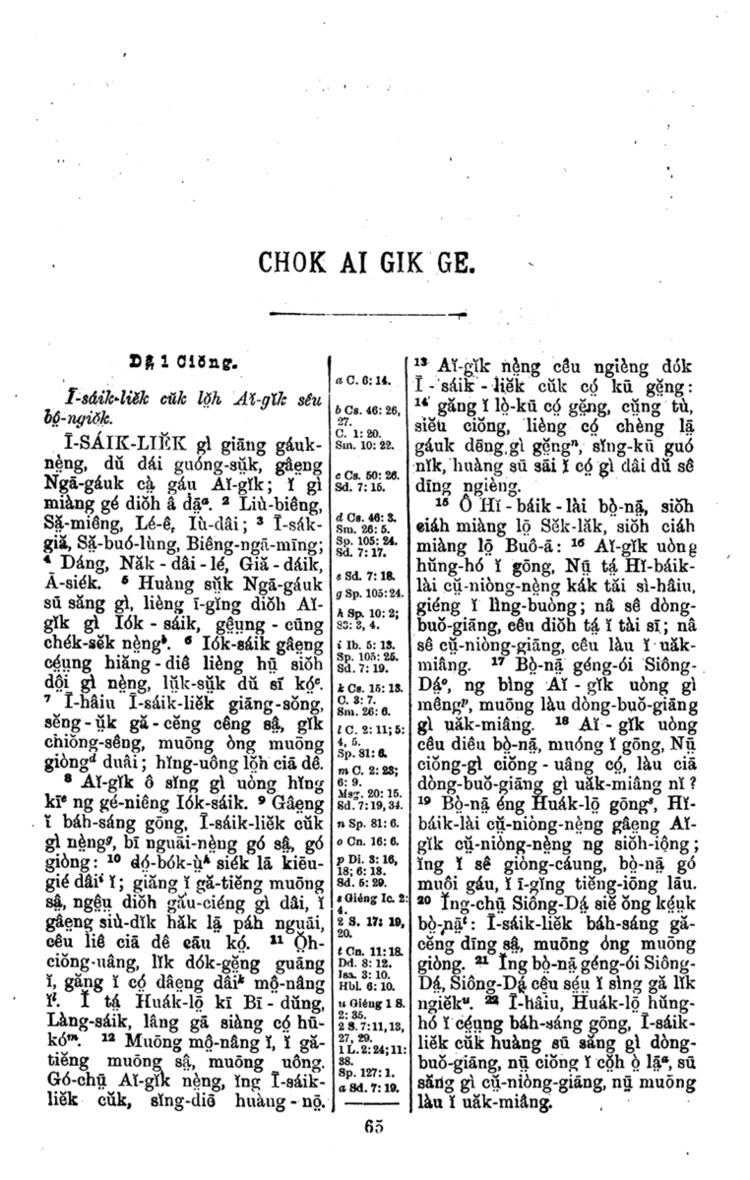Time period late 19th century - ? | ||
 | ||
Type Latin alphabet (modified) Languages Fuzhou dialect of the Eastern Min language Creator Moses Clark White, Robert Samuel Maclay, Caleb Cook Baldwin, Robert Stewart Child systems Hinghwa Romanized, Kienning Colloquial Romanized | ||
Foochow Romanized, also known as Bàng-uâ-cê (BUC for short; Chinese: 平話字) or Hók-ciŭ-uâ Lò̤-mā-cê (Chinese: 福州話羅馬字), is a Latin alphabet for the Fuzhou dialect of Eastern Min adopted in the middle of 19th century by Western missionaries. It had varied at different times, and became standardized in the 1890s. Foochow Romanized was mainly used inside of Church circles, and was taught in some Mission Schools in Fuzhou. But unlike its counterpart Pe̍h-ōe-jī for Hokkien, even in its prime days Foochow Romanized was by no means universally understood by Christians.
Contents
History
After Fuzhou became one of the five Chinese treaty ports opened by the Treaty of Nanjing at the end of First Opium War (from 1839 to 1842), many Western missionaries arrived in the city. Faced with widespread illiteracy, they developed Latin alphabets for Fuzhou dialect.
The first attempt in romanizing Fuzhou dialect was made by the American Methodist M. C. White, who borrowed a system of orthography known as the System of Sir William Jones. In this system, 14 initials were designed exactly according to their voicing and aspiration. ⟨p⟩, ⟨t⟩, ⟨k⟩ and ⟨ch⟩ stand for [p], [t], [k] and [ts]; while the Greek spiritus lenis ⟨᾿⟩ were affixed to the above initials to represent their aspirated counterparts. Besides the default five vowels of Latin alphabet, four diacritic-marked letters ⟨è⟩, ⟨ë⟩, ⟨ò⟩ and ⟨ü⟩ were also introduced, representing [ɛ], [ø], [ɔ], and [y], respectively. This system is described at length in White's linguistic work The Chinese Language Spoken at Fuh Chau.
Subsequent missionaries, including Robert S. Maclay from American Methodist Episcopal Mission, R. W. Stewart from the Church of England and Charles Hartwell from the American Board Mission, further modified White's System in several ways. The most significant change was made for the plosive consonants, where the spiritus lenis ⟨᾿⟩ of the aspirated initials was removed and the letters ⟨b⟩, ⟨d⟩ and ⟨g⟩ substituted for [p] [t] and [k]. In the aspect of vowels, ⟨è⟩, ⟨ë⟩, ⟨ò⟩ and ⟨ü⟩ were replaced by ⟨a̤⟩, ⟨e̤⟩, ⟨o̤⟩ and ⟨ṳ⟩. Since the diacritical marks were all shifted to underneath the vowels, this left room above the vowels which was occupied by the newly introduced tonal marks. Thus Foochow Romanized avoids the potentially awkward diacritic stacking seen for instance in the Vietnamese script, where tone and vowel quality marks both sit above the vowel.
Alphabet
The sample characters are taken from the Qi Lin Bayin, a renowned phonology book about the Fuzhou dialect written in the Qing Dynasty. The pronunciations are recorded in standard IPA symbols.
Tones
Note that Foochow Romanized uses the breve, not the caron (ˇ), to indicate Yīnpíng and Yángrù tones of Fuzhou dialect.
